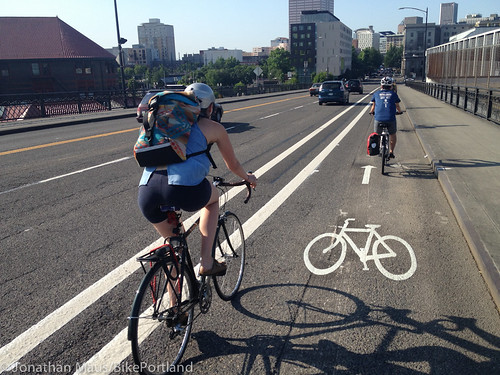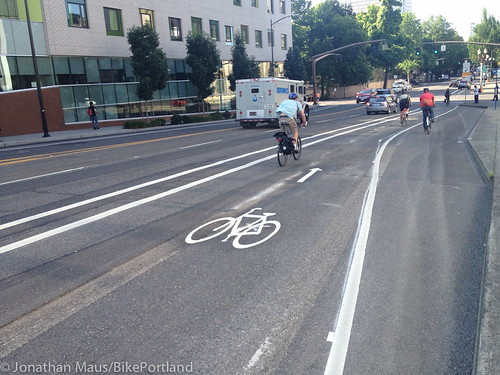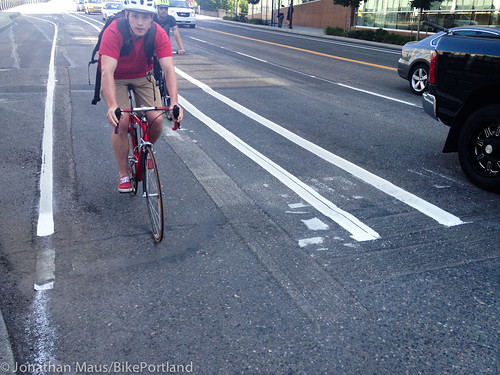
that has been scraped off.)
(Photos © J. Maus/BikePortland)
PBOT is nearly finished with a project to improve bicycling conditions on the NW Broadway ramp south of the Broadway Bridge. The $30,000 project is expected to be finished by tonight but most of the new striping was completed early this morning before rush hour.
In order to create the additional five feet needed for the buffered bike lane, PBOT reduced the amount of vehicle lanes from five to four. Instead of a five-foot bike lane and four, 9.5-foot standard lanes, there is now a 10-foot bike lane and three, 11-foot standard vehicle lanes. The change was made because of the huge amount of people who ride bicycles down this ramp and the need to create safer and more pleasant conditions for them.
I rode it this morning and took a few photos.
Here’s the beginning of the new lane just as you cross the NW Lovejoy intersection…
Note the old bike lane strip that has been scraped off. It’s at the front fork/wheel of the bicycle symbol…
Here’s another view…
The new lane is seven feet wide and there’s a three-foot buffer on the left side. The photo below shows my handebars and a guy passing me for scale…
The width makes riding next to people driving in cars much more pleasant…
Then the buffered lane leaves the curb to make room for the bus stop and position riders to continue south at NW Hoyt…
Here’s where it comes to NW Hoyt. PBOT says they plan to re-install the bike box today…
South of Hoyt they’ve created a shared-lane situation next to the buffer zone (as opposed to the curbside bike lane of old)…
Sharrows approaching NW Glisan…
Still to come are the parking rule changes (and associated signage/markings I presume). Between Glisan and Burnside, people will no longer be allowed to park curbside before 9:00 am. This will open up a nice wide area for bicycling.
Also of note is the northbound side of NW Broadway north of Glisan. Since PBOT went from two standard vehicle lanes to just one, they had room to widen the uphill bike lane and add a buffer…
One last thought: The buffer zones do not have hash marks. The schematic drawing provided by PBOT back in May showed them; but they are not installed. I asked PBOT spokeswoman Diane Dulken about this. Here’s her response:
“Hatch marks are regularly installed in buffer zones of four feet or wider. Barbur Blvd is another example of a buffer that has been installed without the hatching. So the parallel markings serve the purpose of creating a buffer without the added maintenance costs, however incremental, that additional markings would entail.”
Interesting. I think the hash marks are important. They add to the perception of separation and they communicate the intention of the space to road users. Overall, this is a nice, incremental improvement. It’s still just strips of paint without any physical separation or use of color; but it gives people riding bikes a bit more breathing room.
Have you ridden it? What do you think?












